Foreign Devils: A History of the China Trade
- Share via
1557. Ming Dynasty allows Portuguese “foreign devils” to colonize a pirate-infested promontory at the mouth of the Pearl River. The six-square-mile enclave is given the name Macao.
1685. Manchu Emperor Kang Hsi, “the Lord of the World and the Dispenser of Light,” allows “barbarian merchants” to build warehouses for trade in Canton.
1800. Popularity of Chinese silk and tea threatens British treasury, which must pay for items with silver bullion. East India Co. solves problem by introducing the Chinese to opium. England saves its hard currency by exchanging opium for Chinese products, and the British Raj in India gets a new cash crop.
1805. American traders on the Pearl River begin smuggling opium inside converted racing sculls the Chinese nickname “fast crabs.”
1815. American merchants in control of 10% of the opium trade establish a trading post in Canton between Jackass Point and Hog Lane, an alley famous for a numbing drink concocted from alcohol, tobacco juice, sugar and arsenic.
March 27, 1839. Imperial Commissioner Lin Tse-hsu burns 20,000 chests of “foreign mud,” the Chinese term for opium. His action provokes a British declaration of war. A country such as China, declares British Prime Minister Lord Palmerston, “requires a dressing-down every 8 or 10 years.”
Aug. 29, 1842. China loses Opium War and is forced to cede the island of Hong Kong to the British and open five port cities to foreign trade. Outraged that China’s reparations were not greater, Palmerston rebukes his plenipotentiary, Capt. Charles Elliot, and reassigns him to the diplomatic equivalent of Siberia, a newly proclaimed republic called Texas.
July 3, 1844. The United States receives trading rights equal to the British, as well as extraterritoriality, a novel concept that exempts Americans (and later all foreigners) from prosecution under Chinese laws.
February, 1850. Chinese academician Hsu Chi-yu tries to explain the West to humiliated mandarins in a geography book based on secondhand tracts read during his leisure time. Hsu likens the shape of North America to a flying fish. America’s capital, Ko-lun-mi-ah , Hsu writes, is a small district south of Ma-lilan on the banks of the Po-to-mo .
April 16, 1863. The United States and Britain form International Concession in Shanghai. Huangpoo Park on the stately riverside promenade is restricted with a sign at the entrance that reads “Dogs and Chinese Not Allowed.”
June 20, 1900. Peasants resentful of missionaries and their “rice Christian” converts try to expel all “foreign devils.” Because they practice an ancient martial exercise called “harmony fists,” the unsuccessful revolt is called the Boxer Rebellion.
Oct. 1, 1949. Mao Tse-tung proclaims the People’s Republic of China. U.S. traders and diplomats flee.
Feb. 27, 1972. Chinese Premier Chou En-lai and President Richard Nixon sign Shanghai Communique, after which Nixon promises “that never again shall foreign domination, foreign occupation, be visited upon this city or any part of China.”
Jan. 1, 1979. President Jimmy Carter normalizes relations with Peking.
Jan. 24, 1979. Twenty thousand cases of Coca-Cola arrive in Canton, the first American product to be openly sold in 30 years.
Sept. 26, 1984. Britain agrees to give Hong Kong back to China in 1997 in return for Peking’s pledge to preserve capitalism in the colony.
Oct. 10, 1985. U.S. House of Representatives votes to reduce Asian textile imports by 35%. Despite a $400-million U.S. positive trade balance, Chinese textiles would be cut 60%. China threatens to stop buying U.S. computers and aircraft if the measure becomes law.
More to Read
Sign up for Essential California
The most important California stories and recommendations in your inbox every morning.
You may occasionally receive promotional content from the Los Angeles Times.













